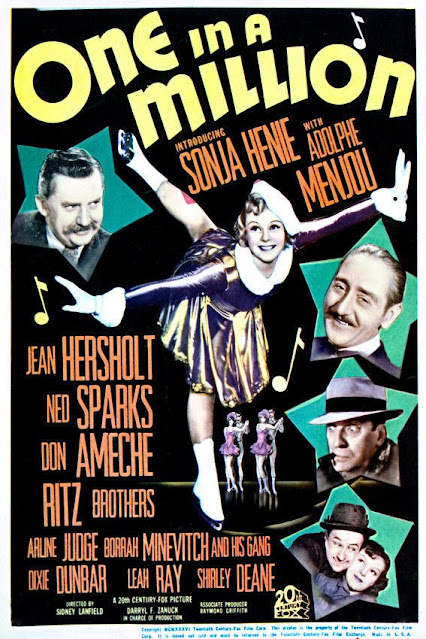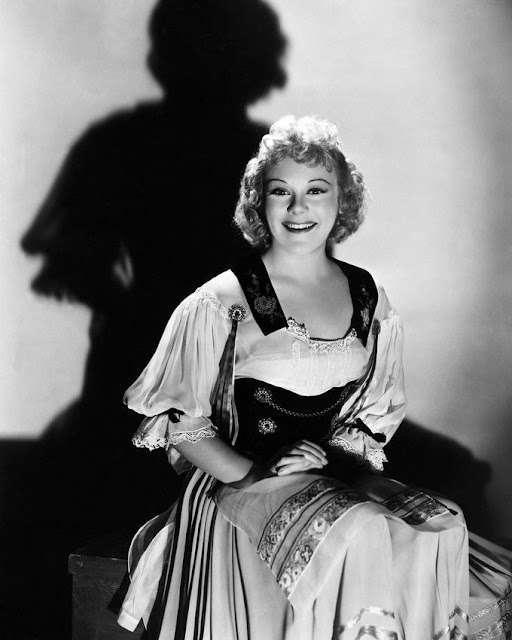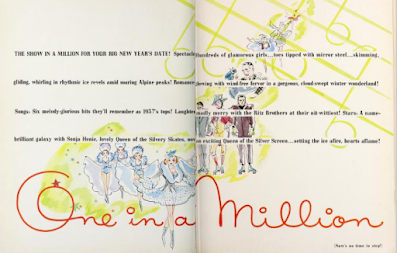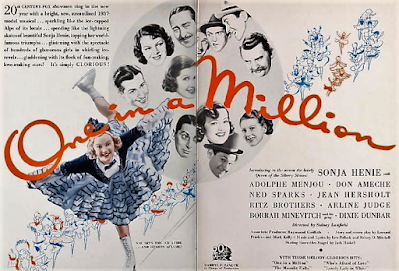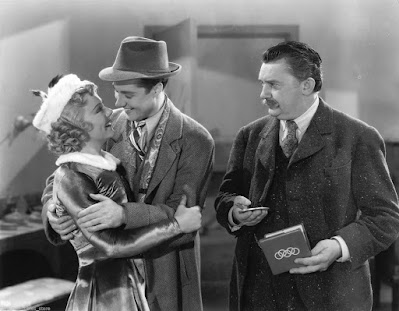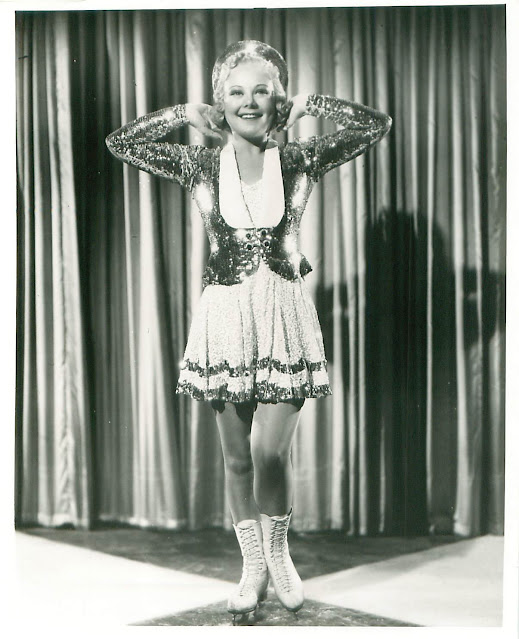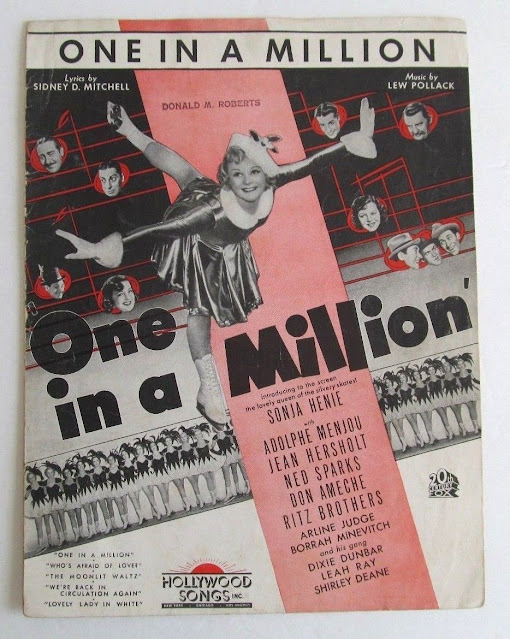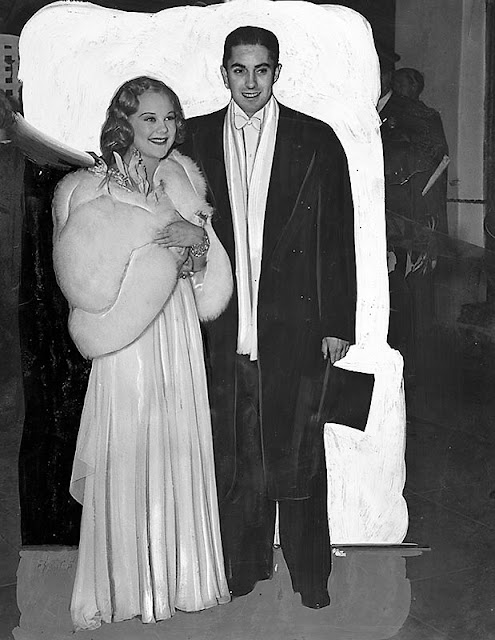For over a decade, Sonja Henie graced the silver screen as one of Twentieth Century-Fox's most exciting 'leading ladies'. In the first of her films, "One In A Million", she portrayed the daughter of a kindly Swiss innkeeper, who aspired to follow in her father's footsteps and win an Olympic gold medal in figure skating.
What many people don't know is that "One In A Million" wasn't supposed to be Sonja Henie's film debut at all. In June of 1936, Twentieth Century-Fox bought a script by Mark Kelly entitled "The Peach Edition", which was written with Henie in mind. After less than two months, the project was scrapped in favour of "One In A Million", a musical written by Kelly and Leonard Praskins. Sidney Lanfield, the genius behind the popular film "Sing, Baby, Sing", was slated to direct the canned film "The Peach Edition" and ended up directing "One In A Million" instead. Don Ameche, Jean Hersholt and Adolphe Menjou and The Ritz Brothers were cast as Sonja's co-stars.
During the production of "One In A Million", Sonja was up at five in the morning every day. Before sunrise, she had her hair shampooed and styled, make-up applied and wardrobe selected before having a quick breakfast of hard bread and coffee with her mother and maid and heading to the studio for eight. She often worked twelve hour days with few breaks. In her book "Wings On My Feet", she recalled, "The moment I arrived at the studio I was caught in a whirlpool of action that never let up until nightfall. Work is in full swing on countless fronts by nine o'clock. An actress playing a scene is constantly moving. I don't mean only skating scenes, as in my case, but the others awell. Sometimes it seems as though you are obliged to shift positions a thousand times in one scene, because you find that somehow you're not quite within vision of the camera. Meanwhile, all around you architects, costumers, technicians and a multitude of others are passing up and down, in and out, going about their apparently unending work... 'One In A Million' grew gradually from a scenario into a collection of assorted skating scenes, love scenes, group action scenes and the rest, all being worked on successively in batches that had the same setting. My first efforts at acting were a pretty serious trial, but I had help from all sides, especially from Jean Hersholt, who was in the film with me and is Danish, a fact that made me turn toward him as a very welcome geographical relative. After a while I made quite a number of friends, and the criticism and exchange of opinions was very valuable. Sometimes they admired in silence and criticized aloud, but that is the way with rival actors, and I knew about rivalry, so it didn't bother me."
Sonja Henie, Don Ameche and Jean Hersholt
The timing of one of the spins in Sonja's program proved problematic as well. She explained, "It never before has mattered where I stopped. I would just spin about twenty or more times, then stop. Sometimes I faced one way, sometimes another. But there was an audience all around me, all four sides of the rink, so it did not matter. But with this picture, they had all the cameras lined up on one side - they could not have them on both, because then they would photograph each other. And I had to stop facing the cameras, and stop in focus, too. I could not do that. It seemed to be impossible. You will not believe this, but from 9:30 in the morning until 2 in the afternoon we worked on that. If I did manage to stop facing the cameras, I would be out of focus. So twice I said not to photograph, just to let me try by myself, and twice I stopped just at the right place - but without the cameras worked."
Sonja's famous temper also made an appearance or two on set. In the book "Queen Of Ice: Queen Of Shadows", Sonja's brother Leif and author Raymond Strait described one incident where the Norwegian ice queen lost her cool after "cut!" was called to many times for her liking during a skating scene. She stormed off with her mother in tow. When Sidney Lanfield caught up to her in her dressing room she remarked, "That son of a bitch wouldn't know a two-step from a rhumba. He stinks." When he said, "He's the best in the business" Sonja replied, "Then he is in the wrong fucking business." Though the matter was resolved, this incident earned Sonja a reputation for being a 'difficult' actress.
Between scenes, Sonja was schooled in barrel jumping by one of the stand-in's for The Ritz Brothers, Canadian speed skater Bert Clark. An easter egg in the film was one of the more famous of the film's four hundred and seventy five extras. Sonja's mother Selma was given a cheque for seven dollars and fifty cents to watch her daughter perform.
Interestingly, a short film from rival studio MGM directed by Pete Smith called "Sports On Ice" came out not long before the release of "One In A Million". It showed clips of Sonja's Olympic performances and 'unconsciously' served as a trailer for the Twentieth-Century Fox film. Even more curiously, a wire to the "New York Times" announcing Henie's arrival on the East Coast to promote the film noted, "She will cooperate with scientists in several experiments, one dealing with calculation of friction coefficient with steel on ice, [another] with possibilities of incorporating anti-sinus gases with ammonia or other gases used for artificial ice-rinks." What gossip columnists were more interested in was the fact she arrived with Tyrone Power, who was enroute to his mother's in Cincinnati for Christmas. Their arrival together sparked rumours that they were engaged. Power had been a regular on the set of the film, and the two were often seen together during her breaks.
"One In A Million" was privately screened to the press in mid-December of 1936 and premiered to the public at the Roxy Theatre in New York on New Year's Eve, 1936. The night before, Sonja gave a skating exhibition on tank ice at the theatre to promote the film. The film was a box office success in America but was banned in Nazi Germany by Propaganda Minister Joseph Goebbels because it featured a The Ritz Brothers... a Jewish comedy trio. In his book "Nordic Exposures: Scandinavian Identities In Classical Hollywood Cinema", Arne Lunde noted, "When Henie telephoned Goebbels' private line at his ministry in Berlin to complain that the picture hadn't played in Germany yet, Goebbels acquiesced by ordering minor cuts (presumably excluding scenes of the Marx Brothers-like Ritzes) and sending 'One In A Million' into successful release within the Reich. Twentieth Century-Fox meanwhile appeared to try to undo a bit of Henie's Aryan image (and its potentially dour and too-German taint) with a publicity photo, the back of which read: 'She's 'crazy' about America, about automobiles and especially her pet white convertible. That non-Norwegian twinkle in her eye? Oh, yes - her grandmother was Irish.'"
Interestingly, a short film from rival studio MGM directed by Pete Smith called "Sports On Ice" came out not long before the release of "One In A Million". It showed clips of Sonja's Olympic performances and 'unconsciously' served as a trailer for the Twentieth-Century Fox film. Even more curiously, a wire to the "New York Times" announcing Henie's arrival on the East Coast to promote the film noted, "She will cooperate with scientists in several experiments, one dealing with calculation of friction coefficient with steel on ice, [another] with possibilities of incorporating anti-sinus gases with ammonia or other gases used for artificial ice-rinks." What gossip columnists were more interested in was the fact she arrived with Tyrone Power, who was enroute to his mother's in Cincinnati for Christmas. Their arrival together sparked rumours that they were engaged. Power had been a regular on the set of the film, and the two were often seen together during her breaks.
Sonja Henie and Tyrone Power. Photo courtesy Los Angeles Public Library.
"One In A Million" was privately screened to the press in mid-December of 1936 and premiered to the public at the Roxy Theatre in New York on New Year's Eve, 1936. The night before, Sonja gave a skating exhibition on tank ice at the theatre to promote the film. The film was a box office success in America but was banned in Nazi Germany by Propaganda Minister Joseph Goebbels because it featured a The Ritz Brothers... a Jewish comedy trio. In his book "Nordic Exposures: Scandinavian Identities In Classical Hollywood Cinema", Arne Lunde noted, "When Henie telephoned Goebbels' private line at his ministry in Berlin to complain that the picture hadn't played in Germany yet, Goebbels acquiesced by ordering minor cuts (presumably excluding scenes of the Marx Brothers-like Ritzes) and sending 'One In A Million' into successful release within the Reich. Twentieth Century-Fox meanwhile appeared to try to undo a bit of Henie's Aryan image (and its potentially dour and too-German taint) with a publicity photo, the back of which read: 'She's 'crazy' about America, about automobiles and especially her pet white convertible. That non-Norwegian twinkle in her eye? Oh, yes - her grandmother was Irish.'"
In retrospect, "One In A Million" was certainly not the flashiest of Sonja Henie's films. Its storyline appeared somewhat 'logical' - if not predictable - for the first film to showcase her skating talents. The stoogey hijinks of The Ritz Brothers and the subplot of Adolphe Menjou's character and his troupe of downtrodden musicians somewhat distract from an otherwise charming film. However, there's a delightful and quaint quality to "One In A Million" that makes it easy to see why Sonja Henie went on to have such success in films in the years that followed.
Skate Guard is a blog dedicated to preserving the rich, colourful and fascinating history of figure skating. Over ten years, the blog has featured over a thousand free articles covering all aspects of the sport's history, as well as four compelling in-depth features. To read the latest articles, follow the blog on Facebook, Twitter, Pinterest and YouTube. If you enjoy Skate Guard, please show your support for this archive by ordering a copy of the figure skating reference books "The Almanac of Canadian Figure Skating", "Technical Merit: A History of Figure Skating Jumps" and "A Bibliography of Figure Skating": https://skateguard1.blogspot.com/p/buy-book.html.

